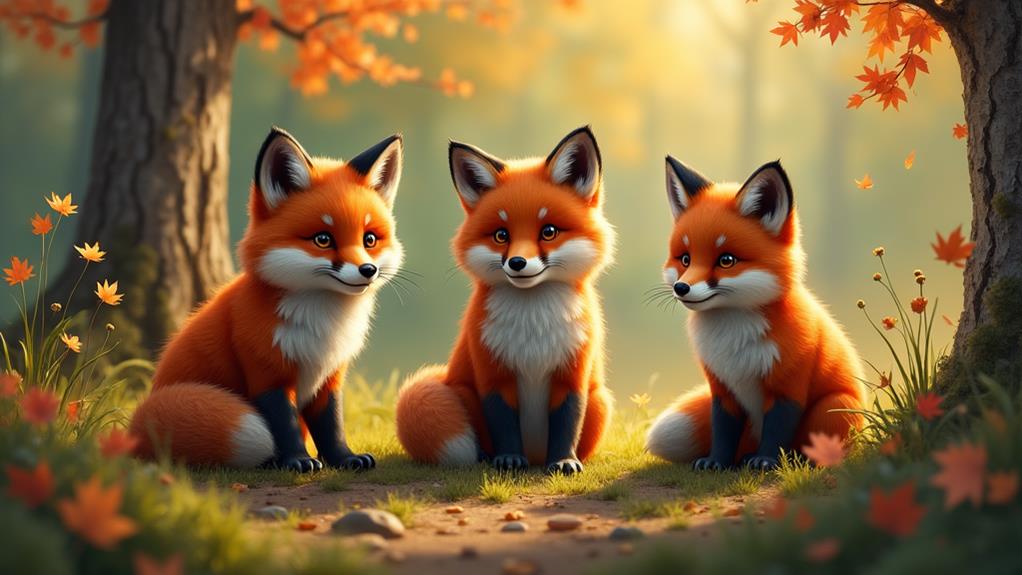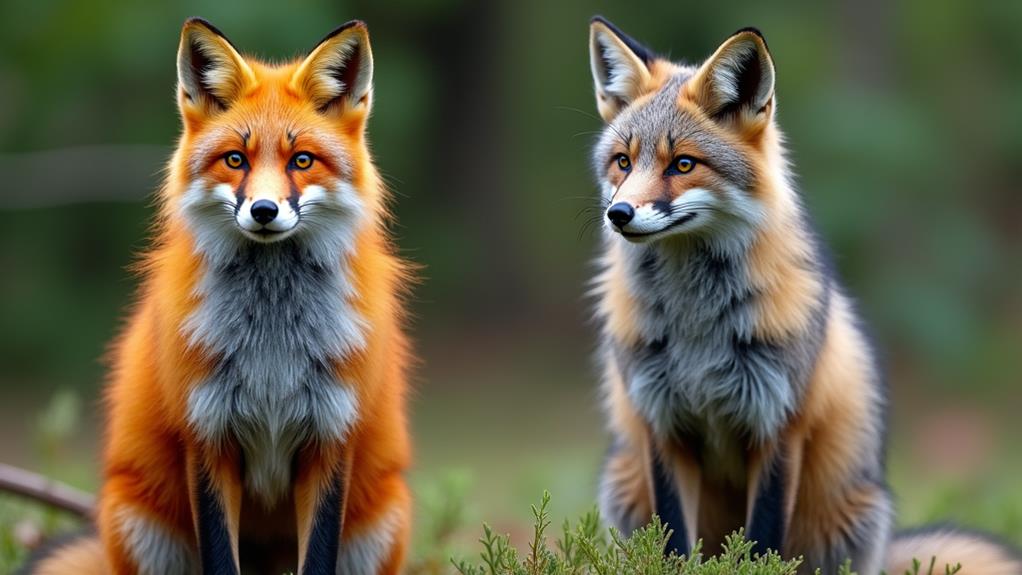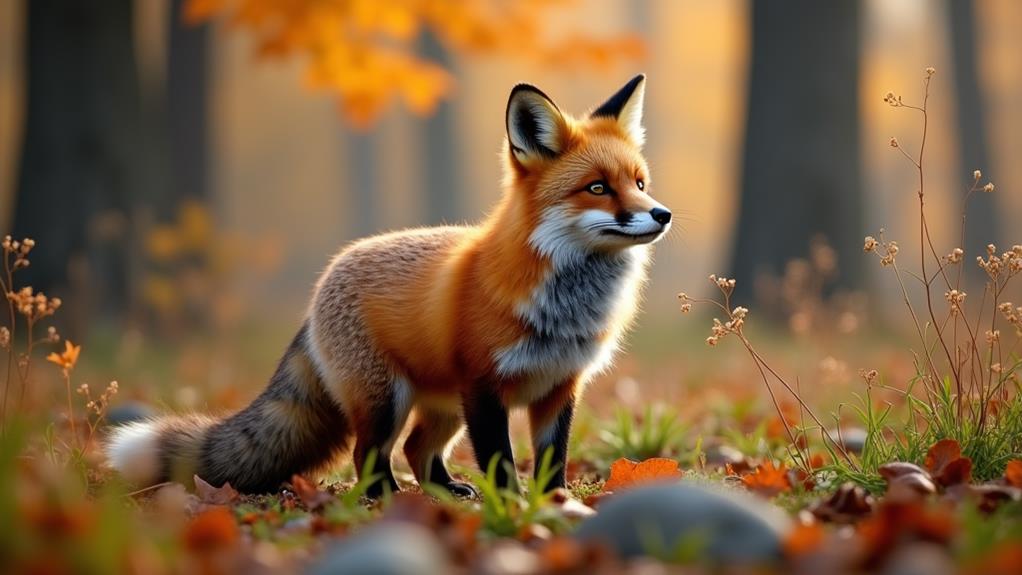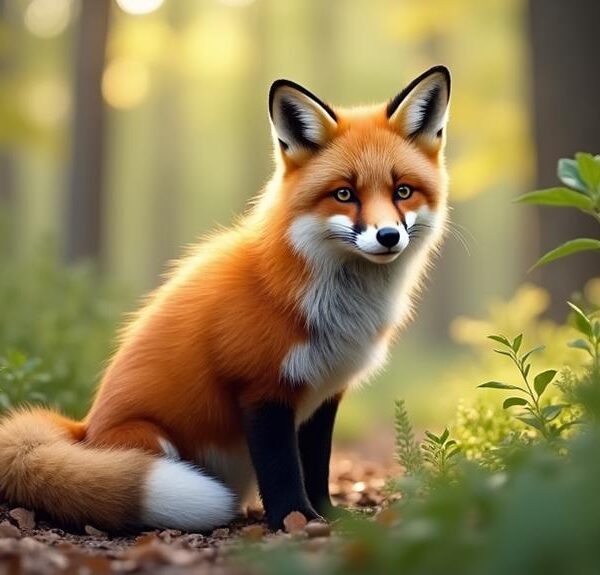Not all red foxes turn gray, but their coats can change a lot! You'll find that genetics, seasonal changes, and their environment all play a role. For instance, when summer hits, many foxes sport lighter coats, which can look somewhat grayish. Also, factors like habitat and diet can cause variations. You might even spot different color phases, like silver or cross foxes. So, while your average red fox isn't turning into a gray ghost, there's a lot of color-changing action going on. Stick around, and you'll discover even more fascinating facts about these clever critters!
Contents
Understanding Fox Color Variability

The red fox's vibrant coat is one of its most distinctive features, yet it comes in a surprising array of colors. You might think all red foxes are, well, red, but they can actually show a range of colors due to genetic factors.
Fox species exhibit fascinating adaptations; whether it's reddish-yellow, dark red, or even those intriguing melanistic variants that appear nearly gray, each coat reflects the fox's unique lineage and environment.
Seasonal moulting plays a role too. In summer, foxes can sport lighter fur, which might make you second-guess whether you're looking at the same red friend. Plus, you've got color variations like cross foxes and silver foxes, showcasing the amazing genetic diversity within their populations.
Did you know that the genetics behind a fox's coat color involves over 100 different genes? Yep, it's true! So, while some red foxes might resemble gray foxes at a glance, they're a completely different species altogether.
Embracing this complexity reminds us how beautiful diversity can be in nature. So, the next time you spot a fox, remember – it might just be dressed in a color that tells a story!
Identifying Red and Gray Foxes
Identifying red and gray foxes can be tricky, especially when you catch a glimpse of them in their shared habitats. You might first notice that red foxes sport striking reddish fur on their backs and faces, while their bellies are grayish-white. Their long snouts and bushy tails, which are white-tipped, add charm to their appearance.
In contrast, gray foxes have a more grizzled gray look, complete with a black streak running down their tails. Intriguingly, both species exhibit adaptations that help them thrive in their respective environments, showcasing the diverse traits of fox species globally.
Now, size can throw you off! Red foxes measure about 22-25 inches long (excluding their bushy tail) and weigh between 8-16 pounds, while gray foxes are a tad smaller, around 30-45 inches including their fluff.
Both may share habitats, leading to confusion when you spot them from afar.
Don't underestimate the importance of their feet either; red foxes have black feet as a distinguishing feature, while gray foxes' feet match their grizzled coats.
If you familiarize yourself with their foraging patterns and behaviors, you'll become a pro at identifying these enchanting critters in no time! So, grab your binoculars and enjoy the show!
Genetics Behind Coat Colors

Behind the striking coat colors of red foxes lies a fascinating interplay of genetics. The coat color of these charming creatures is genetically controlled by at least two genes, leading to variations that produce four main color phases: Red, Silver, Cross, and White. Isn't that amazing?
The red morph makes up about 60% of the population, while the others, like the intriguing silver and cross foxes, showcase the complexity of their genetics. Additionally, the Red Fox is known for thriving in diverse habitats, which may contribute to the variability in its coat coloration their diverse habitats.
You might be surprised to know that seasonal moulting also plays a role. During summer, foxes often sport lighter coats, which could make them appear gray at a glance. This is where misidentification can happen, especially because gray foxes may sometimes overlap in traits, showing a grizzled appearance.
To add to the mix, genetic variations can cause melanistic variants that can easily confuse even the seasoned wildlife enthusiast.
Habitat Influence on Fur Color
Habitat plays a significant role in shaping the fur color of red foxes. You might notice that foxes in arid regions tend to have lighter coats, helping them better blend into their sandy surroundings. In contrast, those living in denser woodlands often sport darker, richer fur. This difference isn't just on the surface; environmental factors like local climate and geography influence the pigmentation of red foxes, creating a beautiful tapestry of colors across populations.
As red foxes exhibit remarkable adaptability, those in urban areas have also been reported to show variations in fur shades, likely reflecting their diverse environments and the availability of foraging opportunities habitats and distribution.
As seasons change, so does their look! Red foxes undergo seasonal moulting, resulting in lighter summer coats that can sometimes give off a grayer appearance. It's like they're preparing for a wardrobe change each season.
Furthermore, within local populations, genetic variations contribute to their diverse coat colors, ranging from vibrant reds to deep grays or even melanistic forms.
With over 100 genes involved in determining coat color, these marvelous creatures showcase a complex relationship between genetics and habitat conditions. So, when you spot a red fox, remember that its fur color tells a tale of adaptation, environment, and a pinch of genetic magic. Isn't nature fascinating?
Behavioral Adaptations and Observations

Red foxes display a fascinating array of behavioral adaptations that help them thrive in diverse environments. Their cleverness extends beyond their striking coat color and includes strategies that can be quite entertaining!
Here are a few ways you might notice their behaviors affecting their appearance:
- Scavenging Habits: Red foxes often search for food in urban areas or around farms, which can lead to fur collecting dirt or debris, causing color variation that may appear grayer or lighter.
- Seasonal Moulting: As the seasons change, so does their coat! In summer, they may shed their thicker fur, revealing lighter colors that can be mistaken for gray foxes.
- Genetic Control: The genes responsible for coat colors can also lead to individuals sporting a grizzled appearance, adding to the confusion in identifying them.
In urban populations, red foxes might've a larger amount of eumelanin, giving them that darker, more grayish look.
These behavioral adaptations and observations highlight the uniqueness of red foxes and remind us to appreciate the beauty in their diversity, ensuring we don't misidentify them as gray foxes!
Final Thoughts
So, do all red foxes turn gray? Not really! Just like how some people might go gray as they age, many red foxes keep their striking color. The secret's in their genes, environment, and maybe even a bit of style. Imagine a fox proudly sporting a vibrant red coat, strutting through the forest like a stylish fashionista. It's a reminder that nature loves variety, and every fox has its own unique story to tell—both in color and personality!














